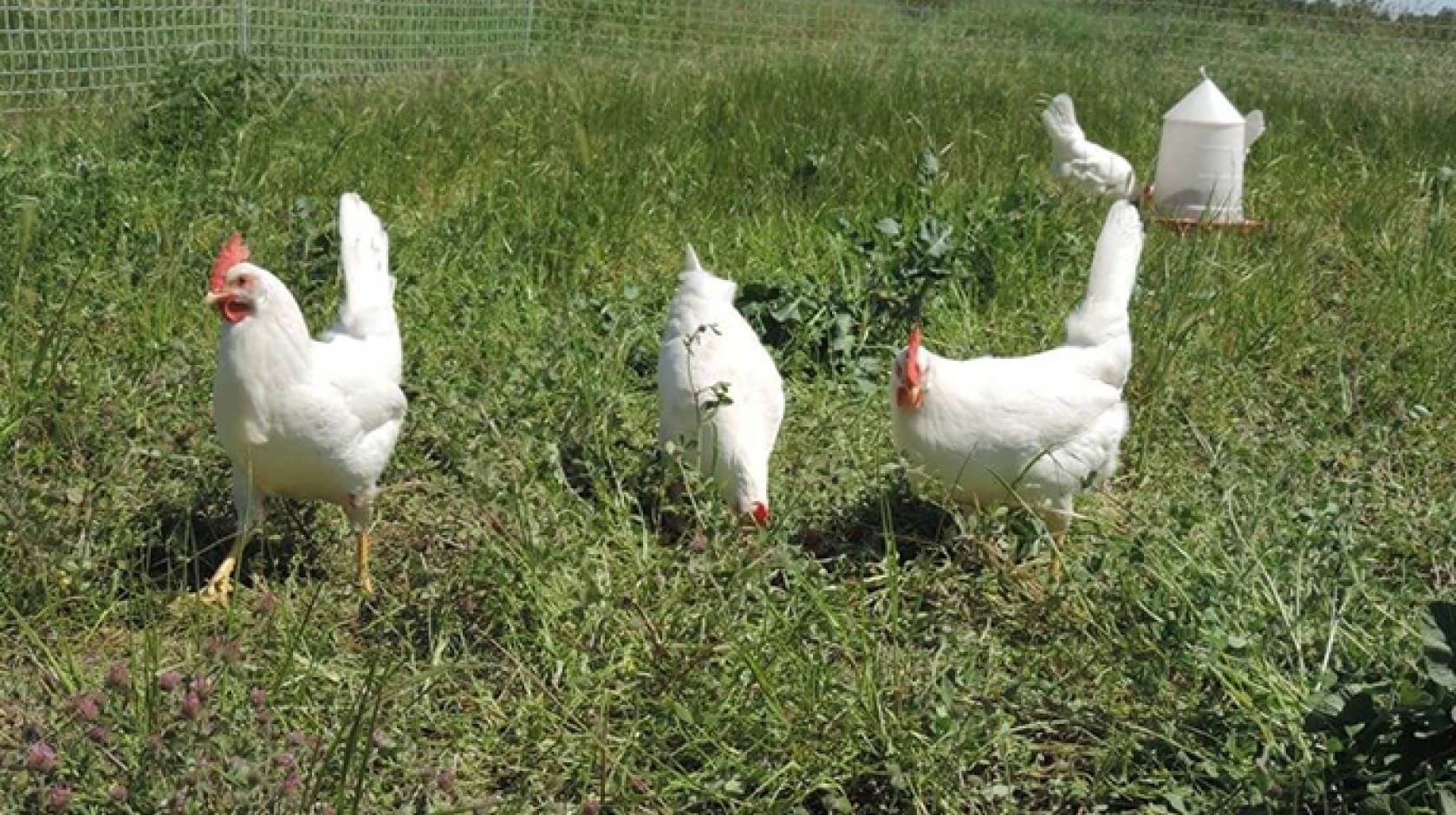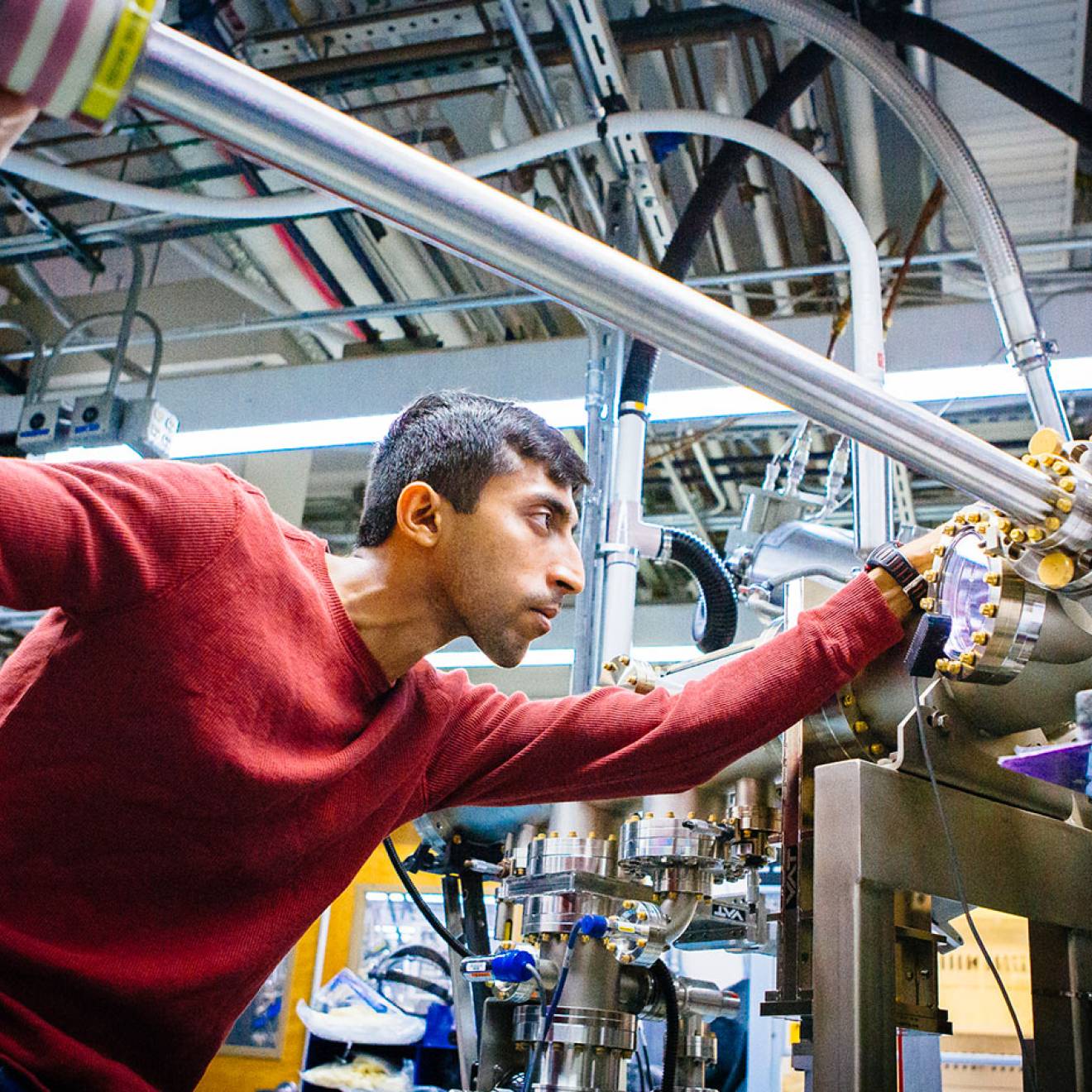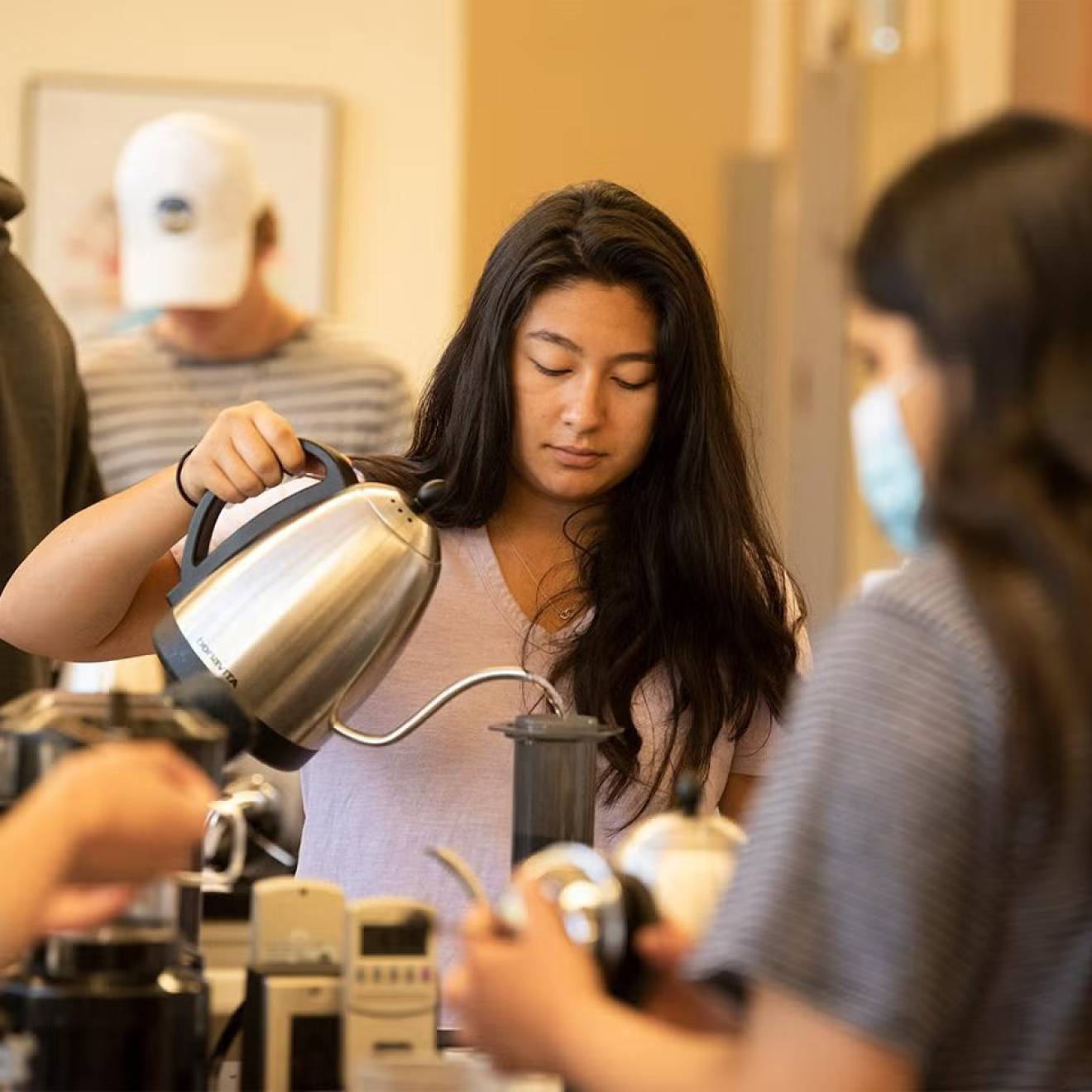Rose Hayden-Smith, UC Food Observer

This is a time of radical change for California poultry, with a large number of commercial farmers moving quickly to pastured, cage-free systems and a rapidly growing group of backyard chicken owners looking for advice.

Credit: UC Davis
That’s why we turned to Maurice Pitesky to get the dirt on these changes to the state’s chicken industry … and to see if the proposed changes are all they are cracked up to be. Pitesky is a Cooperative Extension poultry specialist with the UC Davis School of Veterinary Medicine. He also is the co-leader of the university’s new Pastured Poultry Farm, which opened in September 2015.
This living laboratory – unique in the western states – is where students and researchers hope to develop innovative solutions for pasture-based poultry farms, integrated crop-and-poultry farms and backyard flocks. Here’s more about the 4.5 acre farm.
Q) How is the poultry industry experiencing radical changes in the way egg products are being produced? What are some of these changes?
Pitesky: The first place to start is Prop. 2, which was a 2008 ballot measure in California that received more than 63 percent of the popular vote – the highest proportion for a ballot measure ever passed in the state’s history. This measure had a huge effect on poultry (layer birds) with respect to how much space they were allotted on the farm. Implementation began Jan. 1, 2015.
[Editor’s note: Learn more about Prop. 2 from Dan Charles at NPR.]
Prior to the proposition, the United Egg Producers (UEP) recommended 67 square inches per caged bird, or approximately two-thirds the size of a piece of notebook paper. When Prop/. 2 was passed, there weren’t very clear rules about cage sizes to comply. The state of California turned to UC Davis animal science professor Dr. Joy Mench. Her research lead to the development of a formula to determine the proper cage size to allow caged hens to stand up, fully extend their limbs and turn around freely. Using Dr. Mench’s formula, caged birds require a minimum of 116 square inches per bird.
Prop. 2 has had a huge effect on commercial poultry production in the state and has caused some unintended consequences. Many small farms had to close down. In 2014, there were 18 million commercial laying hens in California. By Jan. 1, 2015, there were only 11 million commercial laying hens. A lot of small farms couldn’t pay for the new infrastructure, or they were unable to survive economically with their current infrastructure and half the number of birds. Another unintended consequence is that California now has to import more eggs from other states.
There are arguments for and against this proposition. The advantages from a welfare perspective, many would argue, are these new rules allocate more space to allow the birds to move freely, lie down, stand up and fully extend their limbs. However, many welfare specialists also believe if you give birds more room, you must also give them enrichments, such as nest boxes, perches and scratch pads. Prop. 2 does not address this. It’s like with small children. If you put them in a small space without many toys, they are probably fine. But if you put them in a larger room with no toys, they are going to start looking for something to do.
Prop. 2 didn’t consider the unintended consequences that come with a larger cage size. In addition, there is no scientific consensus, in my view, that if you give birds more room they are healthier or there are lower rates of salmonella.
Some companies are complying with Prop. 2 by making larger cages, but are not offering enrichment. If you don’t offer enrichment, you’re going to start having welfare and morbidity challenges with your poultry.
In contrast, J.S. West adopted enriched cages and incurred large capital costs to comply with Prop. 2 and also to make the birds productive and healthy. In my opinion, enriched cages are a reasonable middle ground between traditional cages and free-range systems, where birds are out and about in the external environment.
[Editor’s note: Learn more about enriched cages from J.S. West, who says its system is the “first ever enriched colony and the first system of its kind to be certified by American Humane Association.”]
The interesting thing with Prop. 2 is that now companies from Starbucks to McDonald’s are asking for cage free eggs in response to consumer demand. So, now companies are not even using enriched cages, they are going cage free.
So, yes, the poultry industry has gone through huge changes – from a conventional caged system to Prop. 2-compliant cages to now cage-free poultry systems. The pendulum has swung very far, very fast. It will be interesting to see the consequences of these changes over the next three to five years, depending on companies’ compliance with these purchasers’ requests.
People will argue as you move to these systems that there are unintended consequences. Food prices may go up, because if you look purely at production, the UEP guidelines provide the most productive hens. This is because the more space provided, the more feed required to feed those hens, and feed is the most significant cost associated with production.
There are also legal challenges surrounding Prop. 2, due to the commerce clause in the United States Constitution. Should states outside of California have to comply with Prop. 2 if they want to sell eggs in California? In 2009, lawmakers in California passed AB 1437, which requires out-of-state egg producers to be compliant with Prop. 2. However, lawmakers and egg producers from other states are suing the state of California to overturn AB 1437.
[Editor’s note: See our past article on six states that filed an appeal to halt California’s egg law.]
The interesting thing is that many companies, like Target or Costco, don’t care now whether the ruling goes one way or another. They are answering to consumers, and many consumers want cage-free eggs. At the end of the day, the law might not really matter, because consumers really are driving this trend.
These non-conventional poultry systems are quickly becoming much more popular, so one of our areas of interest is to understand and share knowledge about these new commercial, non-conventional poultry production systems. That’s a key reason for the UC Davis Pastured Poultry Farm to act as a resource and provide information for the industry and public.
Q) What are some of the challenges associated with pastured poultry, such as food safety, animal health and welfare, and environmental issues?
Pitesky: A big challenge is predator control, which can cause a producer to lose up to 30 percent of a flock each year. Predators might include raccoons, foxes, opossoms, skunks or coyotes. This dovetails into another huge challenge, which is modernization of these farms. Farmers don’t exactly know how many hens they really have, and they can lose hens to predators without even knowing it. Most of these producers do not collect data that is integral to understanding appropriate pricing. For example, the feed conversion ratio is not calculated, and this is a standard calculation that gives a farmer an indication of how efficient they are with respect to poultry meat or egg production.
The modernization issue is huge for the success of these non-conventional farms. Deb Niemeier, a professor in the School of Engineering and co-director of UC Davis Pastured Poultry Farm, is leading our efforts to use remote sensing, solar panels and Google forms to enhance production and capture data that allows us to understand how productive our birds are. Our goal as researchers is to understand and optimize these systems and then transfer that knowledge to relevant stakeholders.
Husbandry is still key. It doesn’t matter whether the farm is conventional, organic, pasture or free range; all can be run well or run poorly. In my opinion, the best predictors of a well-run operation are the farmer and workers.
There are some regulatory issues on these types of farms. Smaller pasture farms can be challenging, because operations with less than 3,000 laying hens can slip through regulatory requirements, especially salmonella testing. You could make the argument that these operations are lower density than conventional farms, so the hens are under less stress and hence less susceptible to salmonella infection. The counter argument is that the birds are exposed to more wildlife, which may be reservoirs of diseases including salmonella.
Our UC Davis research suggests that the levels of Salmonella enteritidis (SE) – the most common foodborne salmonella found in eggs that cause illness in humans – are comparable between pasture poultry and conventional poultry. However, I would say that we need more research on pastured and free-range systems to be able to make this statement with more confidence.
Another challenge is that most small farms often don’t have their own feed mill and basically have to purchase from commercial sources. Larger farms have access to different ration types and can get specific rations that match the protein and nutrient requirements for their flocks. Smaller farms don’t have that luxury. For example, the farmer often pays for a ration with higher amounts of protein. This can be expensive and also an environmental issue, because the excess protein will get lost in their excrement. That excessive nitrogen and phosphorus can present environmental challenges.
Deb Niemeier is doing research with black soldier fly larvae with the goal of “farming” the larvae on compost and using the larvae as a protein supplement when necessary for poultry. Interestingly, the larvae are natural predators to mosquitoes, so this may serve an interesting dual purpose in some equatorial regions of the world, where the larvae can grow year round due to the climate and can also mitigate mosquito populations.
Q) What about the rise of backyard poultry enthusiasts? What are some of the opportunities and challenges for this group?
Pitesky: We’ve done a lot of work with backyard enthusiasts. Most large cities, especially in California, are trying to come up with rules and regulations regarding the number of birds allowed and such. If done correctly, backyard poultry can be an enjoyable hobby – especially if owners are responsible about husbandry, biosecurity and food safety. If done poorly, backyard poultry can lead to problems with rodents and flies that carry disease.
The most common cause of mortality in backyard poultry is Marek’s disease, which is 99.9 percent preventable. It requires among other things a vaccination at day one of age, or a vaccination in the developing embryo. If you can do one of those two things you can probably prevent the majority of cases.
People tell me they want to raise poultry, because they have a concern about how poultry is conventionally produced. In my opinion, if they truly care about their birds, they should do their best to eliminate Marek’s disease in their flock. In the commercial industry the disease is very rare, because they vaccinate. I tell people to vaccinate, or they are putting their chickens at risk.
I always encourage backyard enthusiasts to register at the UCCE poultry website, where we have the California Poultry Census. Here’s why: If there is an outbreak of the highly pathogenic avian influenza, for example, I can reach most of the state’s commercial poultry producers by sending two emails and warn them to keep their birds inside.
Backyard enthusiasts, on the other hand, are harder to warn. There are approximately 100,000 backyard chicken owners in California, but we only have about 400 in our census. The California Poultry Census is trying to get a good, even distribution throughout the state, so we can share this important information quickly. We are not trying to regulate these chicken owners in any way. We are a university, not an enforcement agency. So our focus is on education and outreach.
The most common question is “I have a sick bird. Where can I find a vet?” Unfortunately, most vets currently don’t know much about poultry, although that is starting to change. Go to our website and click on Got Poultry Issues to access information on who to contact. Currently, we have approximately 20 poultry vets in 15 California counties on our list. Hopefully, we’ll have 30 to 40 on that list in a few years.
Other issues include rooster challenges, but a big question is “What should I do with a sick or dead bird?” People are uncomfortable talking about it. How do you euthanize a bird? People have different levels of comfort with doing certain things and also different economic resources. I always recommend to backyard poultry owners to have a plan: know what you’re going to do if you have a sick or dead bird; know who to contact.
The California Animal Health and Food Safety Lab (CAHFS) has four labs throughout the state, and is an excellent resource for backyard poultry enthusiasts. If you have a sick or dead bird, their necropsy services can help identify the cause of disease. Once identified, you can work with your veterinarian or friendly cooperative extension specialist on how to proceed. In many cases their services are free.
Q) For those of us without backyard chickens, the different labels on egg cartons can be confusing. How can consumers make sense of them?
Pitesky: It is confusing, and labeling is challenging. The USDA has strict definitions on organic and non-organic food products, but it is still developing one for pastured poultry. There are independent auditors who have their own definition, but that can be challenging to interpret because there are different auditing groups with different requirements. Organic means the birds are not raised in cages, have access to the outdoors and are fed an organic ration.
Q) How is UC Agriculture and Natural Resources reaching out to these groups to support them? What are your top priorities?
Pitesky: The biggest things we focus on at UC Davis Pasture Poultry Farm are research, innovation and outreach to commercial pasture poultry and free-range farmers. Currently, there is not as much research focus on these types of farms, in part because they don’t produce as many eggs and poultry meat as their conventional counterparts. However, production of non-conventional poultry is growing.
In England, they receive more than 50 percent of eggs from cage-free systems. This demonstrates that there is the potential (for better or worse depending on how you view these types of production systems) for these systems to be a significant part of our food system. Because of the trends described above, I believe it’s very important that we have the expertise to address questions related to these systems.
Regarding food deserts and food security issues, some would argue for larger, conventional farms, which are perhaps more efficient in several ways. I would partially agree and make a counter argument – for more small, locally owned, integrated farming systems that grow multiple animal and plant crops close to food deserts. I believe poultry are a key to these types of systems, because capital costs in raising poultry are low and, if managed properly, poultry can be integral in crop production.
From a food security perspective in the developing world, you could also argue that conventional poultry production is ideal from an efficiency perspective. However, some regions of some countries lack the infrastructure to feed and manage large poultry farms. By having smaller integrated farms with poultry, the population has access to multiple animal and plant food sources. In short, integrated farms enable you to have calories in more than one bucket, which is an important consideration for food security in some regions of the world.
Learn how you can support the UC Davis Pastured Poultry Farm, and follow it on Facebook.
This work is part of UC’s Global Food Initiative, which is harnessing the institution’s resources to address one of the most compelling issues of our time: how to sustainably and nutritiously feed a growing world population.

